radio Seat Ibiza 2017 MEDIA SYSTEM TOUCH - COLOUR
[x] Cancel search | Manufacturer: SEAT, Model Year: 2017, Model line: Ibiza, Model: Seat Ibiza 2017Pages: 48, PDF Size: 1.5 MB
Page 2 of 48
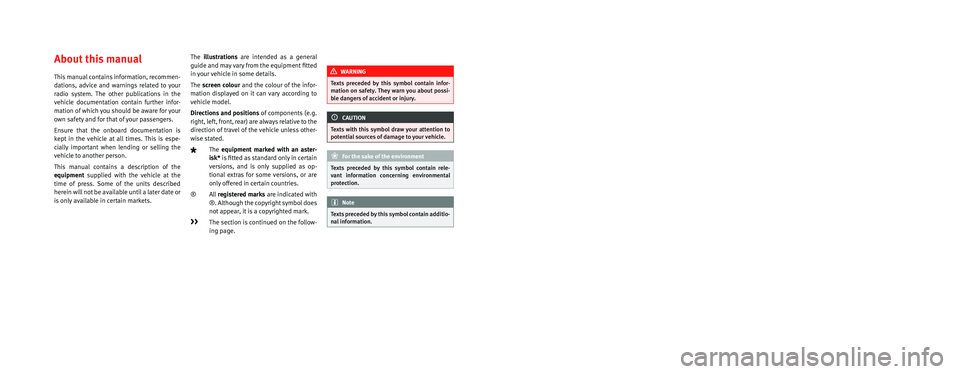
SEAT S.A. is permanently concerned about continuous development of its t\
ypes and models. For this reason we ask you to under-
stand, that at any given time, changes regarding shape, equipment and te\
chnique may take place on the car delivered. For this reason
no right at all may derive based on the data, drawings and descriptions \
in this current handbook.
All texts, illustrations and standards in this handbook are based on the\
status of information at the time of printing. Except for error
or omission, the information included in the current handbook is valid a\
s of the date of closing print.
Re-printing, copying or translating, whether total or partial is not all\
owed unless SEAT allows it in written form.
SEAT reserves all rights in accordance with the “Copyright” Act.
All rights on changes are reserved.
❀This paper has been manufactured using bleached non-chlorine cellulose.
© SEAT S.A. - Reprint: 15.01.17
About this manual
This manual contains information, recommen -
dations, advice and warnings related to your
radio system. The other publications in the
vehicle documentation contain further infor -
mation of which you should be aware for your
own safety and for that of your passengers.
Ensure that the onboard documentation is
kept in the vehicle at all times. This is espe -
cially important when lending or selling the
vehicle to another person.
This manual contains a description of the
equipment supplied with the vehicle at the
time of press. Some of the units described
herein will not be available until a later date or
is only available in certain markets. The
illustrations are intended as a general
guide and may vary from the equipment �tted
in your vehicle in some details.
The screen colour and the colour of the infor -
mation displayed on it can vary according to
vehicle model.
Directions and positions of components (e.g.
right, left, front, rear) are always relative to the
direction of travel of the vehicle unless other -
wise stated.
The equipment marked with an aster -
isk* is �tted as standard only in certain
versions, and is only supplied as op -
tional extras for some versions, or are
only offered in certain countries.
® All registered marks are indicated with
®. Although the copyright symbol does
not appear, it is a copyrighted mark.
>> The section is continued on the follow -
ing page.
WARNING
Texts preceded by this symbol contain infor -
mation on safety. They warn you about possi -
ble dangers of accident or injury.
CAUTION
Texts with this symbol draw your attention to
potential sources of damage to your vehicle.
For the sake of the environment
Texts preceded by this symbol contain rele-
vant information concerning environmental
protection.
Note
Texts preceded by this symbol contain additio -
nal information.
Page 3 of 48
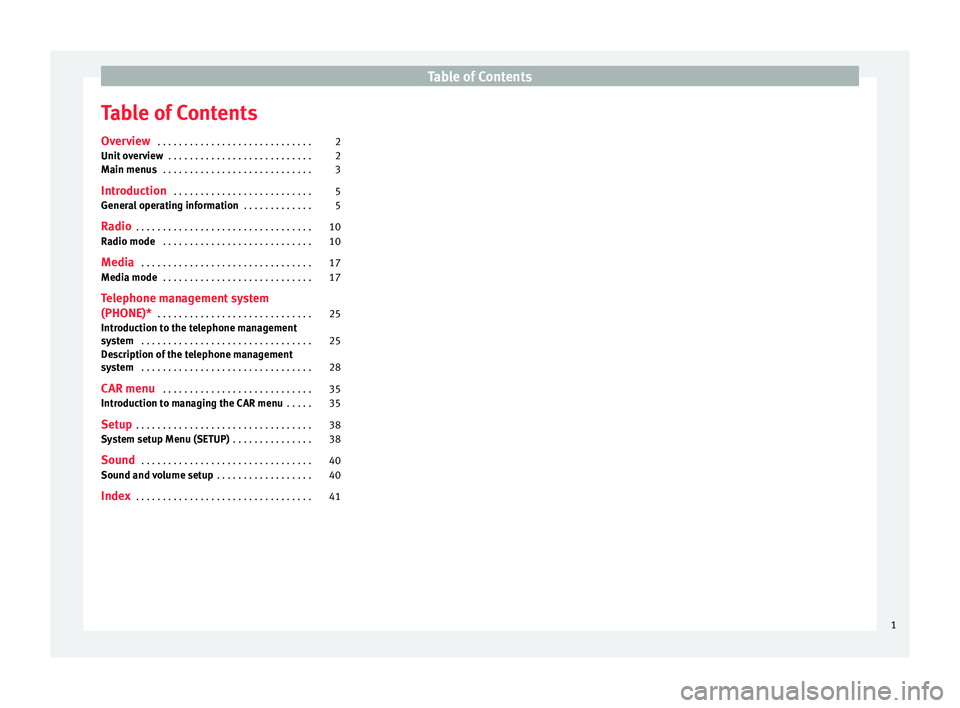
Table of Contents
Table of Contents
Ov erview . . . . . . . . . . . . . . . . . . . . . . . . . . . . . 2
Unit overview . . . . . . . . . . . . . . . . . . . . . . . . . . . 2
Main menus . . . . . . . . . . . . . . . . . . . . . . . . . . . . 3
Introduction . . . . . . . . . . . . . . . . . . . . . . . . . . 5
General operating information . . . . . . . . . . . . . 5
Radio . . . . . . . . . . . . . . . . . . . . . . . . . . . . . . . . . 10
Radio mode . . . . . . . . . . . . . . . . . . . . . . . . . . . . 10
Media . . . . . . . . . . . . . . . . . . . . . . . . . . . . . . . . 17
Media mode . . . . . . . . . . . . . . . . . . . . . . . . . . . . 17
Telephone management system
(PHONE)* . . . . . . . . . . . . . . . . . . . . . . . . . . . . . 25
Introduction to the telephone management
sy
stem . . . . . . . . . . . . . . . . . . . . . . . . . . . . . . . . 25
Description of the telephone management
sy
stem . . . . . . . . . . . . . . . . . . . . . . . . . . . . . . . . 28
CAR menu . . . . . . . . . . . . . . . . . . . . . . . . . . . . 35
Introduction to managing the CAR menu . . . . . 35
Setup . . . . . . . . . . . . . . . . . . . . . . . . . . . . . . . . . 38
System setup Menu (SETUP) . . . . . . . . . . . . . . . 38
Sound . . . . . . . . . . . . . . . . . . . . . . . . . . . . . . . . 40
Sound and volume setup . . . . . . . . . . . . . . . . . . 40
Index . . . . . . . . . . . . . . . . . . . . . . . . . . . . . . . . . 41
1
Page 6 of 48
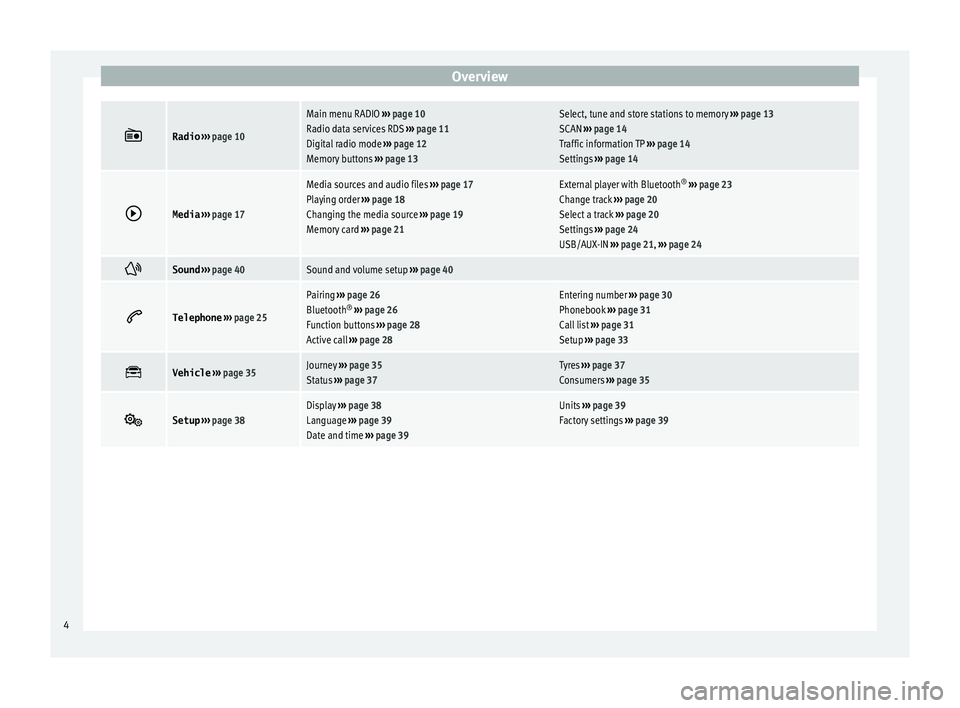
Overview
Radio
› ›› page 10
Main menu RADIO ››› page 10
Radio data services RDS ››› page 11
Digital radio mode ››› page 12
Memory buttons ›› › page 13Select, tune and store stations to memory ›› › page 13
SCAN ››› page 14
Traffic information TP ››› page 14
Settings ››› page 14
Media
› ›› page 17
Media sources and audio files ››› page 17
Playing order ›› › page 18
Changing the media source ››› page 19
Memory card ›› › page 21External player with Bluetooth ®
› ›› page 23
Change track ››› page 20
Select a track ›› › page 20
Settings ››› page 24
USB/AUX-IN ››› page 21, ››› page 24
Sound
› ›› page 40Sound and volume setup ››› page 40
Telephone
› ›› page 25
Pairing ››› page 26
Bluetooth ®
› ›› page 26
Function buttons ››› page 28
Active call ››› page 28Entering number ›› › page 30
Phonebook ››› page 31
Call list ››› page 31
Setup ›› › page 33
Vehicle
› ›› page 35Journey ›› › page 35
Status ›› › page 37Tyres ››› page 37
Consumers ››› page 35
Setup
› ›› page 38Display ››› page 38
Language ›› › page 39
Date and time ››› page 39Units ›› › page 39
Factory settings ››› page 39 4
Page 7 of 48
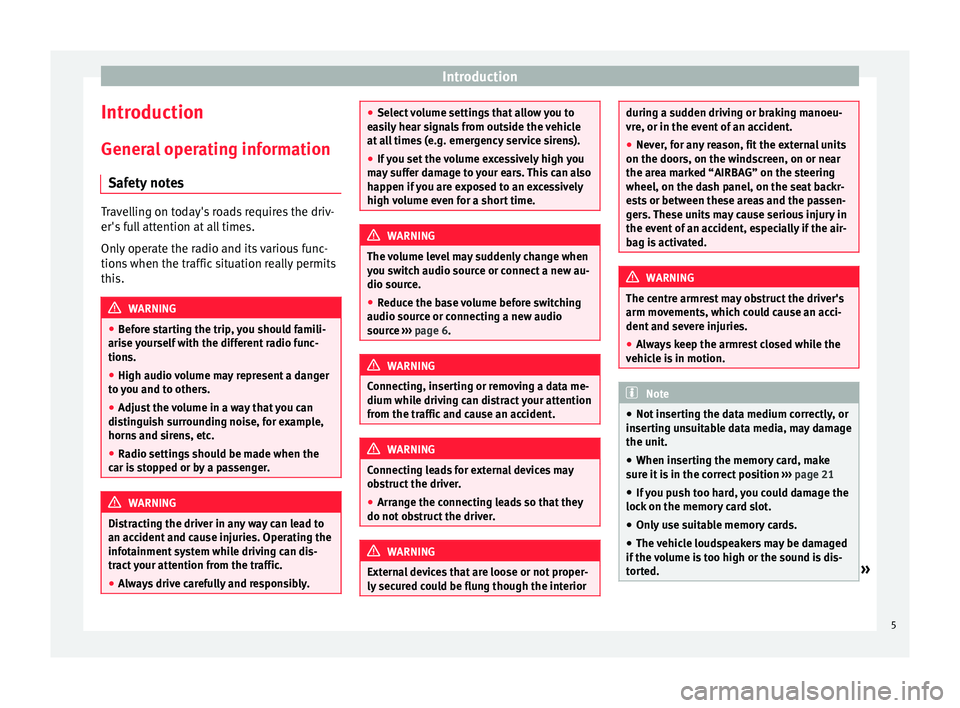
Introduction
Introduction Gener al operating information
Safety notes Travelling on today's roads requires the driv-
er's
full attention at all times.
Only operate the radio and its various func-
tions when the traffic situation really permits
this. WARNING
● B
efore starting the trip, you should famili-
arise yourself with the different radio func-
tions.
● High audio volume may represent a danger
t
o you and to others.
● Adjust the volume in a way that you can
di
stinguish surrounding noise, for example,
horns and sirens, etc.
● Radio settings should be made when the
c
ar is stopped or by a passenger. WARNING
Distracting the driver in any way can lead to
an ac
cident and cause injuries. Operating the
infotainment system while driving can dis-
tract your attention from the traffic.
● Always drive carefully and responsibly. ●
Sel
ect volume settings that allow you to
easily hear signals from outside the vehicle
at all times (e.g. emergency service sirens).
● If you set the volume excessively high you
m
ay suffer damage to your ears. This can also
happen if you are exposed to an excessively
high volume even for a short time. WARNING
The volume level may suddenly change when
y
ou switch audio source or connect a new au-
dio source.
● Reduce the base volume before switching
audio sour
ce or connecting a new audio
source ››› page 6. WARNING
Connecting, inserting or removing a data me-
dium whi
le driving can distract your attention
from the traffic and cause an accident. WARNING
Connecting leads for external devices may
o
bstruct the driver.
● Arrange the connecting leads so that they
do not
obstruct the driver. WARNING
External devices that are loose or not proper-
ly
secured could be flung though the interior during a sudden driving or braking manoeu-
vr
e, or in the event of an accident.
● Never, for any reason, fit the external units
on the door
s, on the windscreen, on or near
the area marked “AIRBAG” on the steering
wheel, on the dash panel, on the seat backr-
ests or between these areas and the passen-
gers. These units may cause serious injury in
the event of an accident, especially if the air-
bag is activated. WARNING
The centre armrest may obstruct the driver's
arm mo
vements, which could cause an acci-
dent and severe injuries.
● Always keep the armrest closed while the
v
ehicle is in motion. Note
● Not
inserting the data medium correctly, or
inserting unsuitable data media, may damage
the unit.
● When inserting the memory card, make
s
ure it is in the correct position ››› page 21
● If you push too hard, you could damage the
loc
k on the memory card slot.
● Only use suitable memory cards.
● The vehicle loudspeakers may be damaged
if
the volume is too high or the sound is dis-
torted. » 5
Page 8 of 48
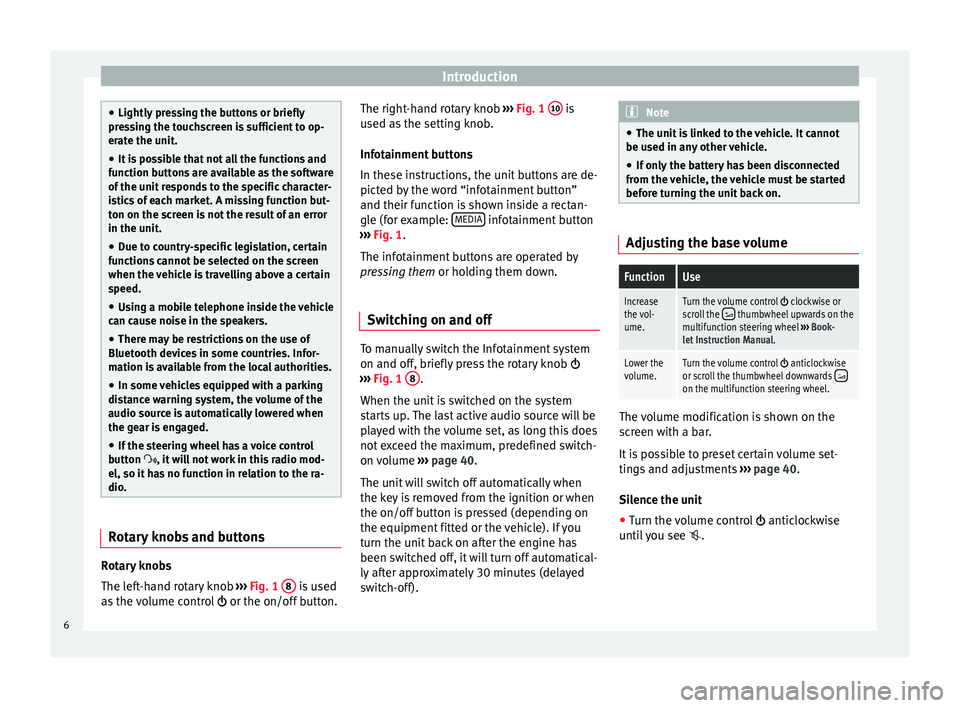
Introduction
●
Lightly pressing the buttons or briefly
pressing the touchscreen is sufficient to op-
erate the unit.
● It is possible that not all the functions and
f
unction buttons are available as the software
of the unit responds to the specific character-
istics of each market. A missing function but-
ton on the screen is not the result of an error
in the unit.
● Due to country-specific legislation, certain
f
unctions cannot be selected on the screen
when the vehicle is travelling above a certain
speed.
● Using a mobile telephone inside the vehicle
c
an cause noise in the speakers.
● There may be restrictions on the use of
Bluet
ooth devices in some countries. Infor-
mation is available from the local authorities.
● In some vehicles equipped with a parking
di
stance warning system, the volume of the
audio source is automatically lowered when
the gear is engaged.
● If the steering wheel has a voice control
b
utton , it will not work in this radio mod-
el, so it has no function in relation to the ra-
dio. Rotary knobs and buttons
Rotary knobs
The l
eft-hand rotary knob ››› Fig. 1 8 is used
a
s the volume control or the on/off button. The right-hand rotary knob
›
›› Fig. 1 10 is
u
sed as the setting knob.
Infotainment buttons
In these instructions, the unit buttons are de-
picted by the word “infotainment button”
and their function is shown inside a rectan-
gle (for example: MEDIA infotainment button
›
›› Fig. 1.
The infotainment buttons are operated by
pressing them or holding them down.
Switching on and off To manually switch the Infotainment system
on and off
, briefly press the rotary knob
››› Fig. 1 8 .
When the u
nit is switched on the system
starts up. The last active audio source will be
played with the volume set, as long this does
not exceed the maximum, predefined switch-
on volume ›››
page 40.
The unit will switch off automatically when
the key is removed from the ignition or when
the on/off button is pressed (depending on
the equipment fitted or the vehicle). If you
turn the unit back on after the engine has
been switched off, it will turn off automatical-
ly after approximately 30 minutes (delayed
switch-off). Note
● The u
nit is linked to the vehicle. It cannot
be used in any other vehicle.
● If only the battery has been disconnected
fr
om the vehicle, the vehicle must be started
before turning the unit back on. Adjusting the base volume
FunctionUse
Increase
the vol-
ume.Turn the volume control clockwise or
scroll the thumbwheel upwards on the
multifunction steering wheel ››› Book-
let Instruction Manual.
Lower the
volume.Turn the volume control anticlockwise
or scroll the thumbwheel downwards on the multifunction steering wheel. The volume modification is shown on the
s
creen with a bar.
It is possible to preset certain volume set-
tings and adjustments ››› page 40.
Silence the unit
● Turn the volume control antic
lockwise
until you see .
6
Page 11 of 48
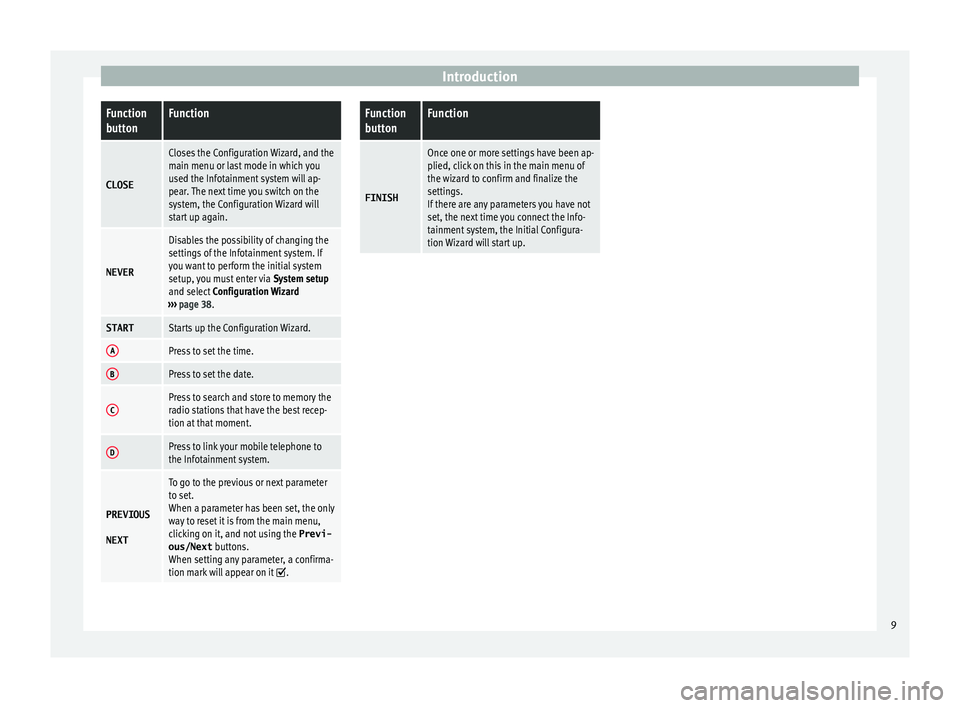
IntroductionFunction
buttonFunction
CLOSE
Closes the Configuration Wizard, and the
main menu or last mode in which you
used the Infotainment system will ap-
pear. The next time you switch on the
system, the Configuration Wizard will
start up again.
NEVER
Disables the possibility of changing the
settings of the Infotainment system. If
you want to perform the initial system
setup, you must enter via System setup
and select Configuration Wizard
› ›› page 38.
STARTStarts up the Configuration Wizard.
APress to set the time.
BPress to set the date.
CPress to search and store to memory the
radio stations that have the best recep-
tion at that moment.
DPress to link your mobile telephone to
the Infotainment system.
PREVIOUS
NEXT
To go to the previous or next parameter
to set.
When a parameter has been set, the only
way to reset it is from the main menu,
clicking on it, and not using the Previ-
ous/Next buttons.
When setting any parameter, a confirma-
tion mark will appear on it
.
Function
buttonFunction
FINISH
Once one or more settings have been ap-
plied, click on this in the main menu of
the wizard to confirm and finalize the
settings.
If there are any parameters you have not
set, the next time you connect the Info-
tainment system, the Initial Configura-
tion Wizard will start up. 9
Page 12 of 48

Radio
Radio R adio mode
Introduction Note
● Pl
ease bear in mind that in car parks, tun-
nels, areas with high buildings or mountains
the radio signal can be impaired.
● Foil or metal-coated stickers attached to
the w
indows may affect reception on vehicles
with a window aerial.
● The availability of AM and DAB bands de-
pend
s on the country and/or equipment.
● The radio stations are responsible for the
c
ontent broadcast. RADIO main menu
Fig. 7
RADIO main menu. Fig. 8
Station list. Press the
RADIO Infotainment button to open
the R
adio main menu ››› Fig. 7.
Radio main menu function buttons
Function
buttonFunction
BANDAllows you to select the frequency band
and memory bank.
STATION
LISTOpens the list of currently receivable ra-
dio stations ›› › page 13.
MANUALAllows you to select the frequency man-
ually ›› › table on page 13.
SETUPOpens the setup menu of the active fre-
quency band ›› › page 14.
INFOAllows you to view the radio text of the se-
lected station.
Function
buttonFunction
or
Selects the previous/next stored station
(or available station). Arrow buttons setup
in the Setup (FM, AM, DAB) menu
› › › page 14.
or Change between station banks.
SCANStops the station scan function (only visi-
ble when the function is running)
› › › page 14.
1 to 12Memory buttons ›› › table on page 13.
UpdatingUpdates the list of stations (AM/DAB)
› › › page 13. Information and possible icons
Display: Meaning
The RDS radio data service is disabled.
TPTraffic news is available .
No stations with traffic news are availa-
ble.
AF offThe tracking of alternative frequencies is
disabled.
The radio station is stored in a memory
button. 10
Page 13 of 48

Radio
Radio Data Services RDS (FM band) Fig. 9
Radio text. Fig. 10
Filter (PTY). The RDS (Radio Data System) offers addition-
al information in FM such as the visualisation
of the station name, automatic station track-
ing (AF), text broadcast by radio (Radio Text
››› Fig. 7), traffic announcements (TP) and sta-
tion type (PTY). Depending on the country and the unit in
que
stion, the RDS can be deactivated in the
FM setup menu ››› page 14.
Without RDS it is not possible to obtain radio
data services.
Station name and automatic station tracking
When the RDS is available, you can view the
names of the stations providing this service
in the RADIO main menu and in the list of FM stations .
The FM stations send different contents un-
der one name (for example, Radio 3) in vari-
ous regional frequencies, provisionally or
permanently ››› Fig. 7.
When driving, the automatic station tracking
automatically changes to the frequency that
provides the best reception of the currently-
selected station. However, this can interrupt
the regional station currently tuned.
The automatic change of frequencies and au-
tomatic station tracking can be configured
through the FM Setup ››› page 14.
Set a station name
In some cases the name of the station is too
long. This text may be blocked/unblocked by
pressing on the station name for 3 seconds.
A dot will appear/disappear to the left or
right of the station name. Radio text
Some RD
S-enabled stations also broadcast
additional text information known as radio
text. The button INFO displays Radio text in-
formation.
Filter by station type (PTY)
With the RDS activated, stations may provide
information on their broadcast content
(news, music, culture, etc.). As seen in figure
››› Fig. 10, it is possible to filter stations by
their content. Note
● D
ue to matters of infrastructure, RDS func-
tions may be limited in certain countries, and
you may not be able to receive traffic an-
nouncements, automatic station tracking (AF)
or programme types (PTY). The TP button will
not function in these countries. 11
Page 14 of 48

Radio
Digital radio mode (DAB, DAB+ and
DMB audio)* Fig. 11
Main DAB RADIO menu. The DAB radio receiver is compatible with the
s
tandards DAB, DAB+ and DMB audio.
In Europe, digital radio is transmitted via
band III frequencies (174 MHz to 240 MHz).
The frequencies of the two bands are referred
to as “channels” and each has a channel
name (e.g. 12 A).
Several available DAB stations are combined
into one channel in an “ensemble”.
Starting DAB radio mode
In the RADIO main menu, press the function
key ›››
Fig. 11 BAND and select
D
AB .
The D
AB radio station that was last selected
will be played if it can still be received at the
current location. The station selected at that time is shown on
the t
op line of the screen. The selected En-
semble of stations is displayed below
››› Fig. 11.
Additional DAB stations
Some DAB stations temporarily or perma-
nently offer additional programmes , (for ex-
ample, for broadcasting sports events).
Additional stations are selected in the same
way as the conventional DAB stations. How-
ever, these are differentiated in the station
list by the icon 2nd.
The name of the additional available station
is displayed in the main DAB menu next to
the symbol .
The additional stations cannot be stored.
From the main
screenPress the name of the main sta-
tion
Press the memory button of the
main station
From the station listSelect the additional station
from the list Automatic station tracking
D
AB is currently not available in all areas . In
areas without DAB, is displayed in DAB ra-
dio mode.
If reception of the currently selected DAB sta-
tion is lost (e.g. no DAB reception available), the Infotainment system attempts to find the
s
tation and tune to it on the other available
frequency bands. If the station still cannot be
found, the radio will be muted. Automatic
station tracking can be activated in DAB set-
tings in the following modalities.
● DAB-DAB station tracking:
The radio at-
tempts to tune into the same station on an
alternative DAB frequency. Automatic station
tracking only works if both DAB stations
transmit the same station identifier or the
DAB signal indicates the other corresponding
DAB station.
● DAB-FM Automatic switching :
The radio at-
tempts to tune into the same station on the
FM frequency band. Automatic station track-
ing between frequency bands only works if
both the DAB station and the FM station
transmit the same station identifier or the
DAB signal indicates a corresponding station
on the FM frequency band. Once the corre-
sponding FM station has been found, FM is
displayed after the station name. When re-
ception for the corresponding DAB station re-
turns, after a short time the unit will switch
back to DAB mode and FM will no longer be
displayed.
Radio text
Some stations also broadcast additional text
information known as radio text. The button
INFO displays Radio text information.
12
Page 15 of 48

Radio
Memory buttons Fig. 12
Group of stored stations. The stations of the currently selected fre-
quency range can be stored on the numbered
function buttons in the RADIO main menu.
These function buttons are called “memory
buttons”.
Functions of the memory buttons
Selecting the station
from the memory
buttons
Press the memory button of the
station you want.
The stored stations can only be
played by pressing the corre-
sponding memory button provi-
ded it can be received at your
current location.
Switching between
memory banks
Press the function button BAND›
›› Fig. 12.
OR ELSE: Press the buttons and on the touch screen.
The memory buttons are dis-
played in three memory banks.
Functions of the memory buttons
Storing the station
on the memory but-
tonsSee: Storing stations ››› table on
page 13. Select, tune and store stations to
memor
y
Selecting a station
Select the sta-
tion with the
arrow buttons
Press the or the function button.
This will change between stored or
available stations, depending on the
setup of the arrow buttons. Arrow but-
tons setup in the Setup (FM, AM
and DAB) menu ››› page 14.
Selecting a
station from a
station listPress the Stations function button to
open the list of stations. Go through
the list and select the desired station
by pressing it. Press the BACK
func-
tion button to return to the previous
screen.
To update the
list of stationsThe list of stations in the FM frequency
band is automatically updated. For the
AM and DAB frequency bands, press
the function button Update
to update
the station list.
Manually tuning in a station frequency.
Viewing the
frequency dialBriefly press the Manual function but-
ton.
Manually tuning in a station frequency.
Adjusting the
frequency in
stagesPress the buttons + –, to the right and
left of the frequency band.
OR: Turn the adjustment knob.
Quickly brows-
ing the fre-
quency bandPlace your finger on the slider in the
frequency dial and drag it along the
dial.
Hiding the fre-
quency bandBriefly press the button Manual.
Storing stations
Storing the
station being
listened to
on a memory
buttonHold down the desired memory button
until you hear the signal. The station
that you are listening to will be stored in
this memory button.
Storing a sta-
tion on the
list of sta-
tionsPress the Stations function button to
open the list of stations. Select the de-
sired station (by holding a finger on the
touchscreen or holding down the setup
button) until the store display appears.
Press the memory button and, after the
confirmation tone, the station will then
be recorded on this memory button.
To store more stations from the list,
press Back and repeat the process.
Deleting a
stored sta-
tionThe stored stations can be deleted one
by one or all at once in the FM, AM and
DAB setup menu. 13